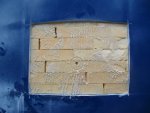sailaboutvic
Well-known member
being back on land for a while and With time on my hand , it been interesting reading what been written over the last two year regarding grounding,
it seems the advise given by some is to have your keel surveyed after a grounding to insure it's not going to fall off.
Does this mean boat are more liable to lose their keels now then they was twenty years ago?
It use to be quite common to sit against scrubbing post or an harbour wall to give a bottom a clean, change the odd sea cock or even antifound the bottom .
I first to admin, back in the days, it's not the first time we went aground tacking up and down the Orwell,
leaving it that bit to late to tack and ended up on the mud or sunking into the mud at pin mill while using a mooring buoy for the night.
Even getting caught out on the Dedham bar,
And other then a look into the bilge to make sure all was well we just carried on sailing just like so many have done before us.
I can understand the need to having your boat checked out after hitting an object at few kts , but really do we all now need go to the expense of an haulout and a surveyor every time we have a small miss hap.
When would you concern having a survey after a grounding?
it seems the advise given by some is to have your keel surveyed after a grounding to insure it's not going to fall off.
Does this mean boat are more liable to lose their keels now then they was twenty years ago?
It use to be quite common to sit against scrubbing post or an harbour wall to give a bottom a clean, change the odd sea cock or even antifound the bottom .
I first to admin, back in the days, it's not the first time we went aground tacking up and down the Orwell,
leaving it that bit to late to tack and ended up on the mud or sunking into the mud at pin mill while using a mooring buoy for the night.
Even getting caught out on the Dedham bar,
And other then a look into the bilge to make sure all was well we just carried on sailing just like so many have done before us.
I can understand the need to having your boat checked out after hitting an object at few kts , but really do we all now need go to the expense of an haulout and a surveyor every time we have a small miss hap.
When would you concern having a survey after a grounding?

